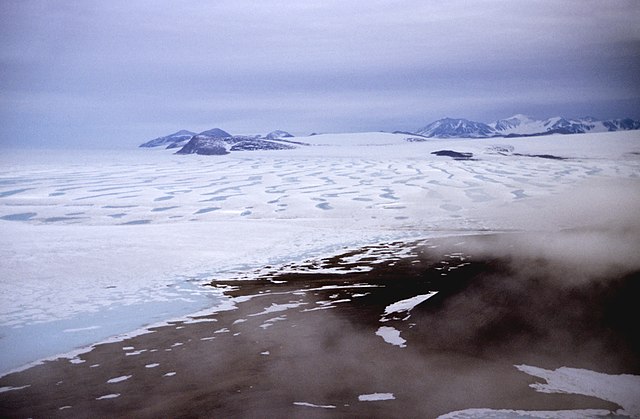Ward Hunt Island is a small, uninhabited island in the Arctic Ocean, located off the north coast of Ellesmere Island near the Ward Hunt Ice Shelf. The island is located just 750 km (470 mi) from the geographical North Pole. The northern cape of Ward Hunt Island is one of the northernmost elements of land in Canada. Only a 17 km (11 mi) stretch of northern coast of Ellesmere Island around Cape Columbia is more northerly. The island is 5.0 km (3.1 mi) long, east to west, and 3.0 km (1.9 mi) wide. The first known sighting was in 1876 by Pelham Aldrich, a lieutenant with the George Nares expedition, and named for George Ward Hunt, who was First Lord of the Admiralty at the time (1874–1877). Today, the Island is part of the Quttinirpaaq National Park.
Walker Hill (439 m (1,440 ft)) on Ward Hunt Island
Twin Otter STOL plane by Bradley Air Services on Ward Hunt Island in 1988
Ward Hunt Island, field camp and airstrip, view towards Cape Columbia, Ellesmere Island, Canada
The old Ward Hunt Island Camp of the CDRB used in the 1960s
The Ward Hunt Ice Shelf is the largest ice shelf in the Arctic, located near Ward Hunt Island, on the north coast of Ellesmere Island, Nunavut, Canada. During the 20th century the Ellesmere Ice Shelf broke up into six separate shelves, the largest being Ward Hunt. Ward Hunt Ice Shelf is currently about 400 km2 (150 sq mi) in size, and has been in place for approximately 4,000 years as part of a continuous ice shelf that encompassed the northern coast of Ellesmere Island until the beginning of the twentieth century. In 2005 one of the other shelves, the 65 km2 (25 sq mi) Ayles Ice Shelf, calved completely.
Ward Hunt Island, Ward Hunt Ice Shelf and Cape Columbia, Ellesmere Island, Canada. View towards east.
Ward Hunt Ice Shelf, north of Ellesmere Island, Canada. View from Ward Hunt Ice Rise towards west, July 1988.






